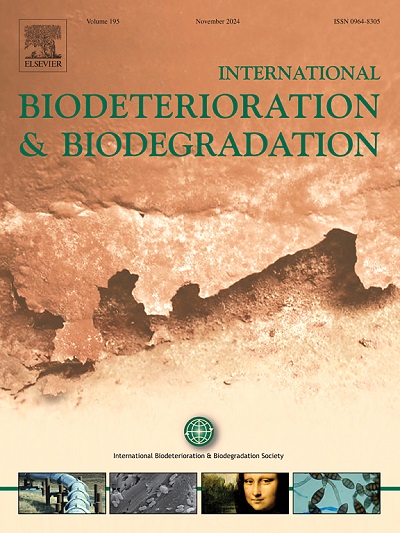Enhancing anaerobic methane production in the co-presence of PLA, TPS, and PBAT mixed under hydrogen-rich conditions
IF 4.1
2区 环境科学与生态学
Q2 BIOTECHNOLOGY & APPLIED MICROBIOLOGY
International Biodeterioration & Biodegradation
Pub Date : 2025-04-13
DOI:10.1016/j.ibiod.2025.106094
引用次数: 0
Abstract
Methane (CH4) production was compared during mesophilic anaerobic digestion (AD) under H2/CO2 purged versus N2 purged, investigating the biodecomposition of polylactic acid (PLA), thermoplastic starch (TPS), and polybutylene adipate terephthalate (PBAT) as the co-presence of PLA/TPS (LS), TPS/PBAT (SB), PLA/PBAT (LB), and PLA/TPS/PBAT (LSB). Therein, 427.37 and 339.22 mL CH4/g volatile solid (VS) were produced endogenously under H2/CO2 and N2 purged, respectively. CH4 production from LS and SB was further increased from 170 to 193 mL CH4/g VS compared to the respective control samples. The degradation of LB and LSB resulted in significantly higher CH4 production under H2/CO2 (157.49 and 229.21 mL CH4/g VS) than under N2 (106.88 and 119.63 mL CH4/g VS, respectively). Metagenome sequencing revealed that H2/CO2 purged led syntrophs of hydrogenotrophic methanogens (e.g., Firmicutes) overcoming higher strengths of fatty acids and utilizing H2 to produce more CH4. Subsequently, PLA and PBAT exhibited breakdowns in the polymer chains and molecular weight along with increased crystallinity. This was confirmed through Fourier transform infrared spectroscopy (FTIR), gel permeation chromatography (GPC), and differential scanning calorimetry (DSC). This study highlights the critical roles of co-digestion with H2 and bioplastics in increasing CH4 production in the AD system.
在富氢条件下,PLA、TPS和PBAT混合共存提高厌氧甲烷产量
研究了在H2/CO2净化和N2净化条件下,聚乳酸(PLA)、热塑性淀粉(TPS)和聚己二酸丁二醇对苯二甲酸酯(PBAT)在PLA/TPS (LS)、TPS/PBAT (SB)、PLA/PBAT (LB)和PLA/TPS/PBAT (LSB)共存在下的生物分解。其中,在H2/CO2和N2净化下,内源产生的CH4含量分别为427.37和339.22 mL /g。与对照样品相比,LS和SB的CH4产量从170 mL /g VS进一步增加到193 mL /g VS。H2/CO2条件下LB和LSB的CH4产率(157.49和229.21 mL CH4/g VS)显著高于N2条件下(106.88和119.63 mL CH4/g VS)。宏基因组测序显示,H2/CO2净化导致氢营养产甲烷菌(如厚壁菌门)的合养菌克服了较高的脂肪酸强度,并利用H2产生更多的CH4。随后,PLA和PBAT的聚合物链和分子量随着结晶度的增加而发生断裂。通过傅里叶变换红外光谱(FTIR)、凝胶渗透色谱(GPC)和差示扫描量热法(DSC)证实了这一点。本研究强调了在AD系统中与H2和生物塑料共消化在增加CH4产量中的关键作用。
本文章由计算机程序翻译,如有差异,请以英文原文为准。
求助全文
约1分钟内获得全文
求助全文
来源期刊
CiteScore
9.60
自引率
10.40%
发文量
107
审稿时长
21 days
期刊介绍:
International Biodeterioration and Biodegradation publishes original research papers and reviews on the biological causes of deterioration or degradation.

 求助内容:
求助内容: 应助结果提醒方式:
应助结果提醒方式:


